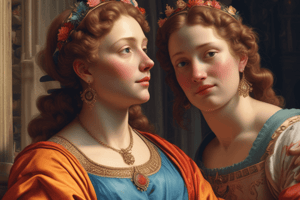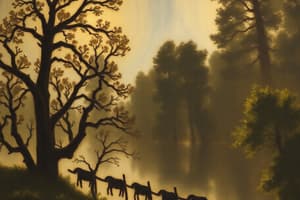Podcast
Questions and Answers
What time period does the Renaissance cover?
What time period does the Renaissance cover?
- 1400-1600 (correct)
- 1520-1580
- 1770-1830
- 1590-1725
What approach to the world does the Renaissance emphasize?
What approach to the world does the Renaissance emphasize?
A secular approach
Which artist is associated with Mannerism?
Which artist is associated with Mannerism?
- Monet
- Rembrandt
- El Greco (correct)
- Picasso
Baroque art is more realistic than Mannerism.
Baroque art is more realistic than Mannerism.
What are common characteristics of Rococo style?
What are common characteristics of Rococo style?
Neoclassicism reflects a desire to rekindle the spirit and forms of classical art from ancient ______.
Neoclassicism reflects a desire to rekindle the spirit and forms of classical art from ancient ______.
What themes does Romanticism emphasize?
What themes does Romanticism emphasize?
Impressionism focuses on social commentary.
Impressionism focuses on social commentary.
Post-Impressionism expressed chaos and complexity of the ______.
Post-Impressionism expressed chaos and complexity of the ______.
What does Cubism primarily focus on?
What does Cubism primarily focus on?
Which artist is known for contributing to Expressionism?
Which artist is known for contributing to Expressionism?
What is a significant influence on Expressionism?
What is a significant influence on Expressionism?
Abstract Expressionism emerged between ______.
Abstract Expressionism emerged between ______.
Flashcards are hidden until you start studying
Study Notes
Renaissance (1400-1600)
- Emphasized rationality and classicism, promoting a secular worldview.
- Innovations included oil painting, point perspective, shading, and natural light.
- Focused on nature and adherence to geometry and mathematics for proportion and scale.
Mannerism (1520-1580)
- Characterized by subjectivity and emotional depth.
- Reflects the turbulence of the Reformation and the Catholic Counter-Reformation.
- Abandoned perspective, with elongated limbs and heavy shadows, exemplified by artists like El Greco and late Michelangelo.
Baroque (1590-1725)
- More realistic and emotional than Mannerism, featuring grand, elaborate styles.
- Linked to the grandeur of churches and monarchs.
- Notable figures include Rubens and Velazquez, alongside developments in music and literature from Bach and Milton.
Rococo (1699-1785)
- Lighter, more ornate style with playful themes and soft lines.
- Utilized light colors, asymmetrical designs, and curves.
- Flourished under Louis XV’s mistress, Madame de Pompadour, with artists like Watteau and Fragonard.
Neoclassicism (1770-1830)
- A revival of classical art forms from ancient Greece and Rome.
- Reflected the principles of order and reason consistent with the European Age of Enlightenment.
Realism (1830-1900)
- Focused on everyday life and ordinary, unidealized subjects.
- Artists depicted real-life situations, moving away from aesthetics and universal truths.
- Important artists include Rembrandt and Vermeer, highlighting the spiritual aspect of life.
Romanticism (1770-1920)
- Rejected Enlightenment’s emphasis on reason and form, favoring emotion and nature.
- Promoted justice and humanity’s goodness, featuring spontaneous plein-air painting.
- Influential writers included Keats and Shelley, alongside a strong presence in music with ballads and folk songs.
Impressionism (1870-1886)
- Centered on capturing fleeting moments and realistic light rather than social critique.
- Abandoned strict lines and perspective, focusing on the immediate sensory experience.
- Key figures included Monet and Renoir, who depicted vibrant, transient scenes.
Post-Impressionism (1880-1905)
- Rejected Impressionism's lack of form, emphasizing chaos and complexity.
- Marked the beginnings of the modern art movement, focusing on line and structure.
- Notable artists include Cezanne, Seurat, and Van Gogh, each offering unique perspectives.
Cubism (1907-1914)
- Prioritized shape and abstraction over traditional representation.
- Rejected linear perspective and chiaroscuro, creating fragmented images viewed from multiple angles.
- Pioneered by Picasso and Braque, introducing a radical new artistic language.
Expressionism (1890-Present)
- Utilized bold colors and strong lines to convey emotional intensity.
- Focused on personal feelings rather than accurate representation, often distorting reality for impact.
- Influenced by African art and the repercussions of Imperialism, with notable artists like Matisse and Van Gogh.
Abstract Expressionism (1947-1965)
- Characterized by spontaneous, automatic, or subconscious creation.
- Focused on expressing emotions through abstraction, leading to a profound impact on contemporary art.
Studying That Suits You
Use AI to generate personalized quizzes and flashcards to suit your learning preferences.




